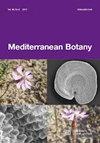camposii苔草亚种。tejedensis(莎草科),是伊比利亚半岛南部一个基于分子、形态和生态分化的新分类单元。
IF 0.7
4区 生物学
Q3 PLANT SCIENCES
引用次数: 1
摘要
苔草路透社。,原产于伊比利亚半岛南部的高山山脉(内华达山脉、菲拉布雷斯山脉和巴扎山脉),是一种形态和分子上明确的物种,包括在金花苔草(苔草亚属,螺科)中。我们在不同的山脉(Sierra de Tejeda)发现了一个形态上与C.camposii相似的物种种群,该种群表现出一些异常的形态特征,并且在与该物种典型栖息地不同的栖息地发现。为了弄清该种群的分类地位,我们使用五个核(ITS、ETS、G3PDH、CATP和GZF)和三个质体(matK、rpS16和5’trnK内含子)DNA区域进行了系统发育分析。此外,还对Sierra de Tejeda的种群进行了形态学分析。由此产生的系统发育树表明,有问题种群的样本与C.camposii密切相关,而形态学研究显示,共有9个形态特征与典型的C.camposi不匹配。尽管来自Sierra de Tejeda的样本在遗传上与C.camposii没有很好的区别,形态和生态分化支持其被识别为一个新的亚种C.camposii subsp。tejedensis。根据国际自然保护联盟的分类和标准对其保护状况进行的评估表明,它可能处于极度濒危状态。本文章由计算机程序翻译,如有差异,请以英文原文为准。
Carex camposii subsp. tejedensis (Cyperaceae), a new taxon for Southern Iberian Peninsula based on molecular, morphological and ecological differentiation.
Carex camposii Boiss. & Reut., endemic to high mountain ranges in Southern Iberian Peninsula (Sierra Nevada, Sierra de los Filabres and Sierra de Baza), is a morphologically and molecularly well-defined species included in Carex gr. laevigata (subg. Carex, sect. Spirostachyae). We have discovered a population of a morphologically similar species to C. camposii in a different mountain range (Sierra de Tejeda), that displayed some deviant morphological characters and was found in a different habitat from that typical of the species. In order to disentangle the taxonomic status of this population, we have conducted a phylogenetic analysis using five nuclear (ITS, ETS, G3PDH, CATP and GZF) and three plastid (matK, rpS16 and 5’trnK intron) DNA regions. In addition, a morphological analysis including the population from Sierra de Tejeda was carried out. The resulting phylogenetic trees show that the samples of the problematic population are closely related to C. camposii, while the morphological study revealed that a total of nine morphological features did not match those of typical C. camposii. Even though the samples from Sierra de Tejeda are genetically not well differentiated from C. camposii, the morphological and ecological differentiation supports its recognition as a new subspecies, C. camposii subsp. tejedensis. An assessment of its conservation status using IUCN categories and criteria suggests that it could be critically endangered (CR).
求助全文
通过发布文献求助,成功后即可免费获取论文全文。
去求助
来源期刊

Mediterranean Botany
Agricultural and Biological Sciences-Plant Science
CiteScore
2.40
自引率
10.00%
发文量
30
审稿时长
12 weeks
期刊介绍:
Mediterranean Botany (ISSNe 2603-9109), formerly Lazaroa, is a biannual journal that publishes original research studies in the field of Botany including plant systematics, vegetation ecology, biogeography, evolutionary biology, ecophysiology, community ecology, ethnobotany and conservation biology on Mediterranean biomes but also in interacting areas.
Mediterranean Botany is an OPEN ACCESS Journal, free of charges for any published article.
 求助内容:
求助内容: 应助结果提醒方式:
应助结果提醒方式:


